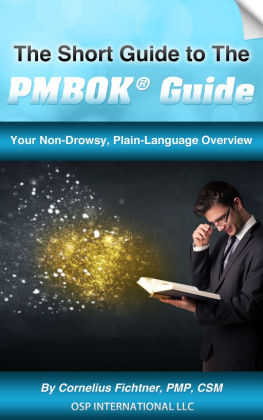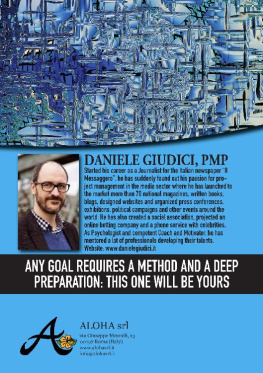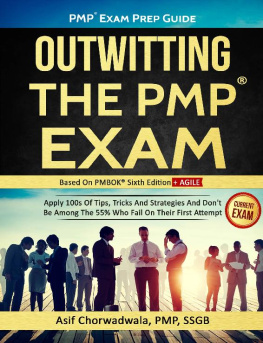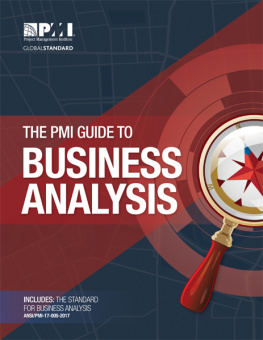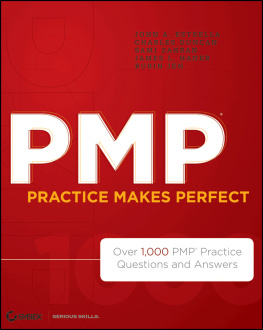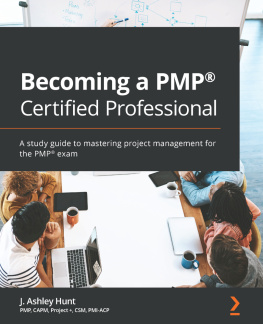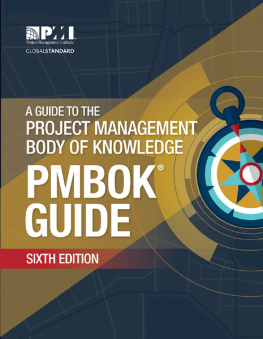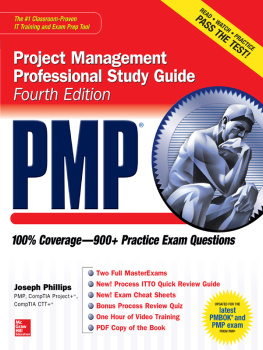The Short Guide to the PMBOK Guide
By Cornelius Fichtner, PMP, CSM
Copyright and Disclaimer:
Published by: OSP International LLC
P.O. Box 863
USA - Silverado, CA 92676
Email:
Internet: www.osp-international.com
OSP International LLC has been reviewed andapproved as a provider of project management training by theProject Management Institute (PMI). As a PMI Registered EducationProvider (R.E.P.), OSP International LLC has agreed to abide by PMIestablished quality assurance criteria.
Copyright 2015 OSP International LLC. Allrights reserved.
The PM PrepCast, The Agile PrepCast, The PMPodcast, The Project Management Podcast, The PDU Podcast and PMExam Simulator are trademarks of OSP International LLC.
Every attempt has been made by OSPInternational LLC to ensure that the information presented in thispublication is accurate and can serve as basic information inpreparation for the Project Management Professional (PMP)certification exam. However, OSP International LLC accepts no legalresponsibility for the content herein. This document or the coursethat it is part of should be used only as a reference and not as areplacement for officially published material. Using theinformation from this document does not guarantee that the readerwill pass the PMP certification exam. No such guarantees orwarranties are implied or expressed by OSP International LLC.
PMI, PMP, CAPM, PgMP, PMI-ACP, PMI-SP,PMI-RMP and PMBOK are trademarks of the Project ManagementInstitute, Inc. PMI has not endorsed and did not participate in thedevelopment of this publication. PMI does not sponsor thispublication and makes no warranty, guarantee or representation,expressed or implied as to the accuracy or content.
This publication is not intended for use as asource of legal, financial or human resource management advice.
Reproduction or translation of any part ofthis work without the permission of the Publisher is against thelaw. No part of this work may be reproduced or transmitted in anyform or by any means, electronic, manual photocopying, recording,or by any information storage or retrieval system, without priorwritten permission by the Publisher.
Version:1.01 Date: 2014-October-11
Table of Contents
Introduction
Are you preparing for the Project ManagementProfessional (PMP) exam?
This booklet will help you!
It is your introduction to the 10 KnowledgeAreas from A Guide to the Project Management Body of Knowledge(PMBOK Guide). The PMBOK Guide is the primarydocument that you have to study for your PMP exam. Unfortunately,it is not a very easily readable document and actually containsquite dry, academic text.
The following 10 articles on the other handgive you an easy to understand executive overview. These articleshelp make The PMBOK Guide much more straightforward andunderstandable for you.
Best of luck to you during your PMP Exam Prepstudies- You are on the right path!
Cornelius Fichtner, PMP, CSM
President, OSP International LLC
www.project-management-prepcast.com
Project Integration Management

You need to beskillful and organized in order to successfully plan and complete aproject. By following the six Integration Management processes, youensure that your project runs smoothly with minimal snags. Ofcourse, there usually are unexpected blips that may come your way,but by following these processes, you can minimize thedisruptions.
First, youmustDevelop aProject Charter. Thisprocess is part of the Initiating Process Group and is so criticalto planning. Through a project charter, you are able to puttogether a formal document that authorizes the project or phase andlists all the high-level requirements that satisfy your client'sexpectations and fulfill their needs. Creating a project charterundoubtedly involves some give-and-take with the client as you coaxout of them exactly what they expect from the project and whatresults they would like to see. Sometimes what the client wants andwhat you can actually deliver may not mesh, so you tactfully ensurethat their expectations remain realistic. Remember that althoughthe client may know what they want, it's unlikely they have thenecessary training or knowledge to determine if what they want ispossible or even practical. Seeing all the plans and projectedoutcomes on paper can serve as an invaluable guide for you and yourteam. The project charter serves to reassure the client that his orher expectations are to be fulfilled professionally andefficiently.
Next,you should Develop a Project Management Planas part of the Planning Process Group. Theproject management plan outlines all the actions that are needed inorder to map out, prepare, integrate, and coordinate all thesecondary plans associated with the project. Remember in school,where you were asked to make an outline before writing a lengthyessay? The project management plan serves a similar purpose. Beforecommencing on the journey that is your project, you use the projectmanagement plan as your roadmap. It allows you to plot out and seehow everything comes together. You refer to the project managementplan quite often during the life of the project, so attention todetail when developing the project management plan could save youfrom running into roadblocks later on in the project. Just as youwould not want to have to re-write your essay due to anill-conceived or senseless outline, you want to have a solidproject management plan to see you through yourproject.
Now, you begin thethird process,Direct and Manage Project Work,which belongs to the Executing ProcessGroup. Within this process, you begin to do the work described inthe project management plan and see the project's objectivesmaterialize. The project charter and project management plan areessential in this stage of the project; they are much like a recipeis to an Executive Chef. If recipes are followed to the letter, youend up with a delectable dish, but if you use poor substitutes ortake inappropriate shortcuts, you end up with an unpalatable mess.Of course, circumstances in your project may dictate that you makea few changes along the way, but it is generally advisable to stickto the project management plan, so that the project charter cancome to fruition in the manner in which you and the clientenvisioned.
The fourth ProcessGroup,Monitoring andControlling,is unique inthat you need to perform it over the course of the entire projectup until Project or Phase Closure.For our discussion about Project Integration Management, thereare two processes within this Process Group that we want tohighlight:Monitor and Control Project WorkandPerform Integrated ChangeControl.
InMonitor and Control ProjectWork,you track yourteam's progress and review every step taken to make sure that youare meeting the objectives in the project management plan. One doesnot need to constantly hover over the team and watch every tinydetail in order to effectively monitor and control. However, it isa good idea to schedule regular meetings to ensure the projectmanagement plan is working well. Regular meetings give your team achance to head off potential situations before they becomeproblems. A relaxed yet professional atmosphere of helpfulness andidea sharing is a great morale booster and keeps schedules ontrack. Any problems that may arise can be discussed and solved inthese regular meetings. You have probably learned that a challengethat may seem to be insurmountable to one person could be a pieceof cake for someone else. Every individual has a differentperspective and expertise that they bring to the table. These teaminteractions help your project to run more smoothly and keep yourteam motivated.

